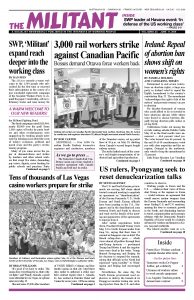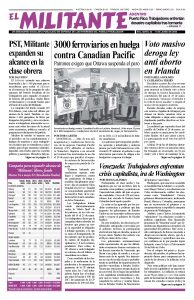The U.S. and North Korean governments are moving full steam ahead toward a summit meeting to negotiate an agreement on “denuclearization” of the Korean Peninsula. U.S., North Korean and South Korean officials have been meeting in the U.S., Singapore and in the demilitarized zone between North and South to discuss and work out the details of the meeting and parameters of the agreements to emerge from it.
After earlier negotiations broke down, President Donald Trump wrote May 24 to North Korean leader Kim Jong Un, saying that their June 12 summit in Singapore was on hold. The liberal ruling-class press — which views almost all politics through their anti-Trump hysteria — proclaimed Trump had blown it and the negotiations were dead in the water. Trump blamed Pyongyang and Beijing for his decision to suspend the summit, saying that officials in the North had expressed “open hostility” to Washington and Beijing had encouraged them.
Nevertheless, the same day, the North Korean government used explosives to destroy the tunnels at its Punggye-ri nuclear testing site, inviting reporters from the U.S. and other countries to observe.
Working people in Korea and the U.S. — whatever their views of President Trump or the regimes in Korea — would welcome an agreement that would remove nuclear weapons from the Korean Peninsula and surrounding areas. Ending U.S. and U.N. sanctions, opening the door to economic growth in the North, and eliminating barriers to travel, communication and economic relations with the Democratic People’s Republic of Korea would be a historic advance for workers and farmers in Korea, Asia and worldwide.
The liberal pundits went on a tirade against the White House. Trump should never have agreed to the meeting in the first place, they said. Trump was “unprepared,” too “hotheaded,” had “excessive expectations,” and would give away the farm at any meeting.
The next day President Trump made it clear plans were still moving ahead for the summit and that sometimes sharp exchanges between Washington and Pyongyang were all part of negotiations. Former Democratic President Jimmy Carter joined those urging Trump be considered for the Nobel Peace Prize.
Trump, like all his predecessors in the White House, defends the interests of U.S. imperialism. The measures he has implemented, including tightening the squeeze on working people in North Korea, are nothing new. But unlike previous U.S. administrations, the Trump White House has succeeded in getting the government of China to significantly step up its implementation of sanctions and the resulting hardships on working people in the North. Some 90 percent of North Korea’s trade is with China.
Kim has made ending North Korea’s economic isolation a priority. At the end of April he announced the Workers’ Party had adopted a “new strategic line,” retreating from investment in armaments to focus on rebuilding the country.
US rulers leveled Korea
The 1950-53 Korean War was a result of the division of Korea by Washington, along with Moscow, after the second imperialist world war ended with the defeat of Japan’s capitalist rulers. They did so against the will of the Korean people.
Washington crushed revolutionary mobilizations in the South and, after the war broke out, used massive bombing and napalm to level virtually every building in North Korea and — on only a slightly lesser scale — in the South.
The capitalist-class morality of the U.S. rulers was demonstrated by their decision to wipe out whole towns and villages. More than 4 million people were killed during the war, half of them civilians.
Despite the odds, Korea’s motivated fighters, with the aid of Chinese volunteers, fought U.S.-led forces to a stalemate at the 38th parallel — the first time U.S. imperialism was defeated in battle.
The U.S. government signed a cease-fire agreement with Pyongyang in 1953 but has refused to this day to sign a permanent peace treaty. This is one of the steps now being discussed.
Preparations for the summit
On May 26 South Korean President Moon Jae-in and North Korean leader Kim met in Panmunjom. According to press reports, Moon hopes to travel to Singapore during the summit for what would be the announcement of a formal peace treaty.
On May 28 a delegation of Sung Kim, U.S. ambassador to the Philippines; Allison Hooker, director of Korea for the National Security Council; and other U.S. officials met with a North Korean delegation in the demilitarized zone to discuss meeting arrangements.
On May 29, the White House said it was holding off beginning tighter economic sanctions planned against North Korea.
After consulting with Chinese officials in Beijing, Gen. Kim Yong Chol, a high-ranking official in North Korea, arrived in Washington May 30. He will meet with Secretary of State Mike Pompeo, reportedly to discuss what steps toward denuclearization can be decided.
Discussions also concern the massive arsenal of nonnuclear weapons the North has amassed on the demilitarized zone aimed at Seoul 30 miles away, as well as withdrawal of some U.S. forces from the South.
Once Washington-North Korea agreements are signed, Trump says Washington will work to ensure that other governments will join South Korea and Japan to help finance economic development in the North, and to assure the protection of the North Korean government.
“We welcome recent steps that have opened the road to agreement by Seoul, Beijing and Washington to sit down at the table with the DPRK for talks,” the Socialist Workers Party said in a message to North Korean leaders last month.”
“The stakes have never been higher in ensuring a nuclear-free Korean Peninsula and Japan, including an end to Washington’s nuclear ‘umbrella’ and deployment of nuclear-armed warships and submarines in the surrounding seas and skies,” the SWP said.
“Korea is one!”

